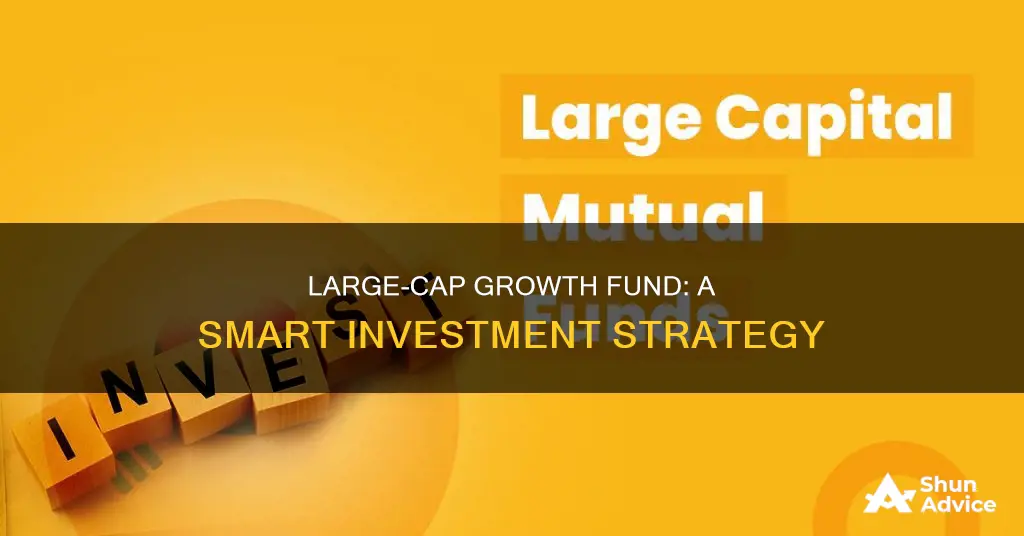
Large-cap growth funds are a type of investment portfolio that focuses on stocks of large companies that are projected to grow faster than other large-cap stocks. These stocks are defined as those in the top 70% of the capitalization of the US equity market. Large-cap growth funds are considered high-risk, high-reward investments, making them ideal for investors with a long-term horizon and a healthy risk tolerance. There are two main ways to invest in large-cap growth funds: by purchasing individual stocks or by purchasing a fund. When investing in individual stocks, it is important to diversify your portfolio to minimize risks. On the other hand, purchasing a fund allows investors to outsource the work of identifying growth stocks, assembling a portfolio, and rebalancing it. Some popular large-cap growth funds include the Vanguard Mega Cap Growth ETF and the iShares S&P 500 Growth ETF.
What You'll Learn
- Large-cap stocks are defined by their market capitalization, with stocks in the top 70% of the capitalization of the US equity market defined as large-cap
- Large-cap growth funds are considered high risk and are best suited to investors with a long-term investment horizon and a healthy risk tolerance
- Large-cap growth funds can be volatile, with high price-to-earnings ratios, and they may pay low or no dividends
- Large-cap stocks are a good choice for inclusion in most investor portfolios, but broadly diversified index funds are the best way to invest in them
- Large-cap blend funds provide the broadest exposure to the overall market and are not as subject to market vicissitudes as large value or growth funds

Large-cap stocks are defined by their market capitalization, with stocks in the top 70% of the capitalization of the US equity market defined as large-cap
Market capitalization is calculated by multiplying the number of a company's shares by its stock price per share. This calculation is used to determine the market size of a company and is an important characteristic considered by investment companies and individual investors.
Large-cap stocks represent a significant portion of the US equity market and are often used as core portfolio holdings. They are typically transparent, making it easy for investors to find and analyze public information about them. Large-cap companies are also often dividend payers, as they are established and have committed to high dividend payout ratios.
Large-cap stocks are generally considered safer investments than mid-cap and small-cap stocks due to the established nature of the companies. However, large-cap stocks may not offer the same potential for high returns as their smaller counterparts.
A Guide to Investing in the Philequity PSE Index Fund
You may want to see also

Large-cap growth funds are considered high risk and are best suited to investors with a long-term investment horizon and a healthy risk tolerance
Large-cap growth funds are a type of investment portfolio that focuses on stocks of large companies with high growth potential. These companies are typically in the top 70% of the equity market capitalisation and are expected to grow faster than their peers or the overall market. While these funds offer attractive returns, they are also considered high risk and are best suited for investors with a long-term investment horizon and a healthy risk tolerance.
Large-cap growth funds are characterised by their focus on large, well-known companies with strong growth prospects. These companies are often leaders in their respective industries and have the potential to expand their businesses and increase their value faster than other companies. This makes them attractive investment opportunities for those seeking capital appreciation. However, it's important to remember that all investments carry some degree of risk.
The high-risk nature of large-cap growth funds stems from the potential volatility of the underlying stocks. While these companies have high growth expectations, any failure to meet those expectations can lead to sharp declines in their stock prices. Additionally, since these companies tend to reinvest their earnings, they may be more vulnerable during market downturns as investors may favour more stable income-generating investments.
Large-cap growth funds are therefore best suited for investors with a long-term investment horizon. These funds typically require a holding period of at least five to ten years. Investors considering large-cap growth funds should have a healthy risk tolerance and be comfortable with potential fluctuations in the value of their investments. It's important for investors to carefully consider their financial goals, risk appetite, and time horizon before investing in these funds.
When investing in large-cap growth funds, it's crucial to conduct thorough research and due diligence. Investors should evaluate the fund's performance, volatility measures, and the underlying companies' growth prospects. Diversification is also key to managing risk. By investing in a diversified mix of large-cap growth funds across different sectors and regions, investors can help mitigate the impact of individual stock or sector performance on their portfolio.
Invest in HDFC Mutual Fund: Secure Your Future
You may want to see also

Large-cap growth funds can be volatile, with high price-to-earnings ratios, and they may pay low or no dividends
Large-cap growth funds are a type of mutual fund that focuses on investing in the stocks of large companies, which are defined as those in the top 70% of the capitalization of the equity market. These funds are designed for investors seeking long-term capital growth and are generally considered safer than other stock funds due to their focus on large, well-established companies. However, it's important to remember that all investments carry risk.
One of the key characteristics of large-cap growth funds is their potential for high volatility. This means that the share prices of these funds can fluctuate significantly over time, which may not suit risk-averse investors. This volatility is driven by various factors, including economic changes and market sentiment. During periods of slow economic growth or market downturns, large-cap growth stocks can be particularly vulnerable as investors may choose to sell these stocks in favour of more stable income-generating investments.
Large-cap growth funds also tend to have high price-to-earnings ratios. This means that the share price of these stocks is relatively high compared to their earnings, which can make them appear overvalued. Additionally, these funds may offer low or no dividends as the companies they invest in tend to reinvest their profits back into the business to fuel further growth. Dividends are payments made by companies to their shareholders, typically on a quarterly, monthly, or annual basis. While large-cap growth funds may provide limited dividends, other types of funds, such as dividend-focused mutual funds, prioritise regular dividend payments, which can be attractive to investors seeking a steady income stream.
The decision to reinvest profits instead of paying dividends is common among high-growth companies, as they aim to maximise their expansion and increase their market share. This strategy can be beneficial for investors seeking capital appreciation, as it allows the companies to expand their operations, potentially leading to higher share prices over time. However, it's important to note that this approach can also lead to higher susceptibility to market downturns, as investors may be less inclined to hold onto these stocks during periods of economic uncertainty.
While large-cap growth funds offer the potential for significant capital gains, it's crucial for investors to carefully consider their risk tolerance and investment goals before committing. These funds are generally recommended for those with a long-term investment horizon and a healthy appetite for risk. Diversification is also essential to mitigate the impact of volatility and potential losses.
American Funds: The Investment Agent's Favorite Choice Explained
You may want to see also

Large-cap stocks are a good choice for inclusion in most investor portfolios, but broadly diversified index funds are the best way to invest in them
Large-cap stocks are a good choice for most investor portfolios, but broadly diversified index funds are the best way to invest in them.
Large-cap stocks are stocks that fall within the top 70% of the capitalization of the equity market. They are typically well-known, large companies with solid reputations, such as Apple, Microsoft, and Amazon. These stocks are generally considered to be a more stable and conservative investment choice when compared to small- or mid-cap stocks. Large-cap companies are often better equipped to weather economic downturns and usually offer dividend payouts, making them attractive to investors.
Large-cap stocks have historically generated strong returns over time and are a key foundation for many investor portfolios. They offer a blend of stability and growth potential, with robust financial foundations and experienced management teams that can effectively navigate market changes.
When it comes to investing in large-cap stocks, there are two main approaches: purchasing individual stocks or investing in a fund. While buying individual stocks has become more accessible due to commission-free trades and fractional shares, it also carries additional risks. Owning a single or even a small number of stocks leaves investors vulnerable to stock-specific risks, as the odds of things going wrong are much higher than with a diversified portfolio.
Broadly diversified index funds, on the other hand, offer a more prudent approach to investing in large-cap stocks. Index funds harness the collective wisdom of the market to determine the relative value of each stock in a given benchmark. They are also more cost-effective, with lower annual expenses compared to actively managed large-cap stock funds.
By investing in a broadly diversified index fund, investors can gain exposure to a wide range of large-cap stocks, reducing the risk associated with individual stocks while still benefiting from the overall gains in the market. This diversification helps to balance out the risks and increases the potential for long-term financial gains.
Mutual Fund Investors: Declare Investments in Your ITR
You may want to see also

Large-cap blend funds provide the broadest exposure to the overall market and are not as subject to market vicissitudes as large value or growth funds
Large-cap blend funds are a type of equity fund that holds a mix of both growth and value stocks. Stocks in the top 70% of the capitalization of the U.S. equity market are defined as large-cap. Blend funds are considered fair representations of the overall U.S. stock market in terms of size, growth rates, and price. The blend style is assigned to portfolios where neither growth nor value characteristics predominate.
Large-cap blend funds tend to invest across a broad spectrum of U.S. industries. Due to their broad exposure, their returns often align with those of the S&P 500 Index. This broad exposure also means that large-cap blend funds are not as susceptible to market fluctuations as large value or growth funds.
Some examples of large-cap blend funds include:
- T. Rowe Price U.S. Equity Research Fund
- Northern US Quality ESG Fund
- BlackRock Exchange Portfolio
- Vanguard PrimeCap Fund
- T. Rowe Price US Large-Cap Core Fund
- DFA US Sustainability Core 1 Portfolio
- Vanguard Dividend Growth Fund
- Pear Tree Quality Fund
- JPMorgan US Equity Fund
- T. Rowe Price Dividend Growth Fund
Large-cap blend funds are a good option for investors looking for broad exposure to the overall U.S. market while reducing their susceptibility to market volatility.
Best Fidelity Funds to Maximize Your 401(k) Returns
You may want to see also
Frequently asked questions
Large-cap growth funds invest in the stocks of larger companies. Stocks in the top 70% of the capitalization of the U.S. equity market are defined as large-cap. A growth fund is a mutual fund or exchange-traded fund (ETF) that includes companies that are likely to have faster revenue or earnings growth than their industry peers or the overall market.
Large-cap companies are usually found in the market's leading benchmark indexes, such as the S&P 500, the Dow Jones Industrial Average, and the Nasdaq Composite. Large-cap stocks are also extensively researched and liquid due to being widely held by many investors.
Large-cap growth funds are generally considered high-risk investments. They can be volatile, have high price-to-earnings ratios, and may pay low (or no) dividends. They are also very sensitive to economic changes and can be susceptible to market downturns.
There are two main ways to invest in large-cap growth funds: by purchasing individual stocks or by purchasing a fund. For most investors, broadly diversified index funds are the best way to invest. Some examples of large-cap growth funds include the Vanguard Mega Cap Growth ETF and the iShares S&P 500 Growth ETF.







